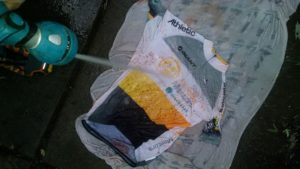-By Terry Ritter
Back on May 13th of this year, during the first lap of the inaugural Port City Criterium, I took off after a break and rolled my tire in the fast downhill corner. I was able to scrub off some speed but this tumble at 30 mph left me with a hairline fracture in my left scapula and a right one in four pieces. For good measure, I also compressed three vertebrae and broke two ribs. Though not needing surgery was a good outcome, I was worried right away that I might not be ready for my favorite mountain bike race, Ore to Shore. I’ve faithfully competed in 17 of the 19 editions.
My shoulders have been deteriorating for years and I have been less than optimal on keeping up on the exercises needed so they stay MTB functional. That meant in the 2016 O2S my shoulders got the best of me and I completely came apart with ten miles to go, getting dropped from my group in a new single track section. I feared the same thing for this season. However, I was diligent with my recovery and physical therapy, pushed myself to get back on the bike and race as soon as I could (week 6 post crash), and hoped for the best.
One thing that didn’t need more confirmation was how switching to a lower carbohydrate diet had left me less need to consume nutrients during an event or ride. Two winters ago I did an experiment with Cricket and Mark of Athletic Mentors, doing metabolic testing (VO2 Max and Aerobic Threshold) work to see how doing a ketogenic diet (very low-carb) would impact my cycling. More specifically, I wondered how it would increase my fat burning, which it improved greatly. However, at least in the 4 month experiment we used, I lost a significant enough ability to do work anaerobically (short term power) that I had to bring some sugars back into my diet to be effective with a number plate on my bike.
What else was it like being a ketogenic athlete (also called “fat adapted”)? Well, our bodies burn glucose if it’s in our diet significantly, and that’s the case for most. For this reason, the brain and nerves are committed to using glucose. When it’s too low, we bonk. But, the hallmark of a ketogenic adaptation is to give the brain and nerves another fuel, one the muscles and other organs happily burn as well: ketone bodies. And the liver can make these all day from our own fat stores. This allowed me, at least for those 4 months, to totally disconnect my eating and working out. I did 1800-2000 kcal workouts and hadn’t eaten in 6-8 hours, something I could never have dreamed of in my past high carb. life.
When I did reintroduce carbs. during the race season, I cut them back significantly from the “aerobic athletes needs carbs. for fuel” mantra I’d heard for decades. And, my power came back. However, I also noticed a significant reduction in what I needed to take in to race well during an event. My daily dietary carbs. through the season typically run 200g or less, depending on training days, many days 100 or less.
How does this math workout in a race? A calorie is just another unit of work, so a power meter, which measures kilojoules very accurately, can determine this value within a few percentage points. The 91 mile Cherry Roubaix took about 3100 kcals to complete. I did have a reasonable breakfast, but only had to take about 600 kcals in during the ride. The Ore to Shore was likely in the 2500 kcal range for work, but I only consumed about 400 kcals during the event…and didn’t finish either effort with any signs of hunger.
The net result is I have learned I don’t need to consume what now looks to be ridiculous levels of carbohydrates to able to perform well. Going this route has enhanced my fat burning ability, meaning I can use my own body stores, a good thing for other reasons besides athletic performance. And, though this is an entirely different topic, I believe it’s much healthier to consume fewer carbs., likely as little as we can. So, this bodes well with where I want my health to go.

The futile attempt to remove the special “mud” that exists at times in the Marquette area. We had some pretty substantial water on the course this year, creating rust colored puddles filled with iron particles. I have to give it a try, though, and now this kit will serve as attire for all O2S races in the near future.
Oh, and how’d the Ore to Shore end up? Well, I was just hoping to get to that place 10 miles before the finish still able to race the race. Darn if all that physical therapy didn’t do the trick and I was able to hang with the top 3 guys (and gal, as the lead women raced with us) as they attacked our group of 15 and made a separation. I was able to push all the way to the finish. This was good enough to squeak in 54th overall. Now, all I have to do is find the motivation to keep these shoulders stronger without rolling around on the pavement as motivation.










